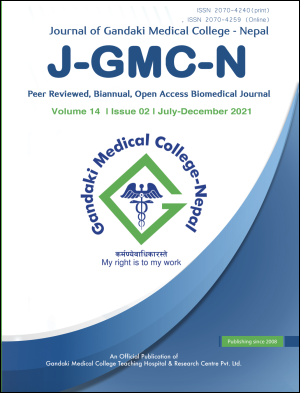Role of Nasal parameters in gender determination among medical students
DOI:
https://doi.org/10.3126/jgmcn.v14i2.40899Keywords:
Mesorrhine, Nasal breadth, Nasal height, Nasal indexAbstract
Introduction: Anthropometric measurement of the nose has a great importance to differentiate gender, race, and ethnicity. Nasal index is an important parameter in forensic sciences and rhinoplasty surgery. Our aim is to compare the nasal index of both males and females and its role to identify gender differences among medical students.
Methods: First and second year medical students were chosen and height, breadth and nasal index were calculated. The height and width of the nose was measured using a vernier caliper. The nasal index of both males and females were calculated and compared and based on this, the nasal shape was also determined.
Results: Among 184 total participants, 114 (61.9%) were Nepalese and 70 (38.1%) were Indian. In the Nepalese cohort, mean nasal height for male students was 4.58 ± 0.37 cm which was higher than females (4.39 ± 0.34 cm). The mean nasal index was higher among males in students of both the countries. The mesorrhine was most common type of morphology found among all students.
Conclusions: Nasal index of male medical students was significantly higher than females. Mesorrhine nose was the commonest type of nose in our study. This information may be used to estimate gender differences.
Downloads
Downloads
Published
How to Cite
Issue
Section
License
Copyright (c) 2021 Bhima Neupane, Kanaklata Iyer, Brihaspati Sigdel

This work is licensed under a Creative Commons Attribution-NonCommercial 4.0 International License.
This license allows reusers to distribute, remix, adapt, and build upon the material in any medium or format for noncommercial purposes only, and only so long as attribution is given to the creator.




